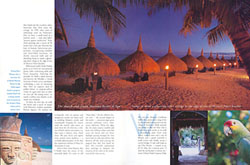| Artwork | Index | Editorial Writing | |
| Books | About | Links |
| Mary Heebner |
|
"Rhapsody in Maya Blue" Carribean Travel & Life |
see also Mary's Isla
Negra Series see the book On the Blue Shore of Silence see the Cenote series |
 |
Maya blue. If not for that particular hue, I might
not have wed the man of my dreams. Years ago, my future husband
Macduff, an ardent romantic who claims he'd been pursuing me for 15 years,
visited my painting studio and showed me a photograph he'd taken of a
Maya ruin overlooking the Caribbean at Tulum. Incredulous that such a
color even existed, I blurted, "Take me there!" Stunned and
delighted, he did just that. Another 15 years later, flying over the easternmost tip of the Yucatan peninsula, in the state of Quintana Roo, I again found myself gazing down at a cuff of pure sandy white extending for miles, unraveling like skeins of cotton thread over a globe of blown blue glass. Macduff and I had come to revisit what for us was still one of the world's most romantic places. On this stretch of coast, dubbed the "Riviera Maya," the Cancún tourist boom has spread southward, but with more care taken to ensure that development doesn't overwhelm environment. |
Highway 307 runs from Cancún to Chetumal,
then beyond into Belize - you can cover the 82-mile Riviera Maya segment
(Cancun to Tulum) in around two hours. The clutter of billboards, gas
stations, dive shops, cybercafés, mechanics, and real-estate
agency signs along the road are the honky-tonk glue supporting this
Riviera's pocket paradises. But take any turn seaward (found by kilometer
marker plus instructions along the lines of, "a few meters beyond
the billboard for Coke, head down a dirt path and drive for three kilometers")
and enter a world apart. It's this world we decided to explore, of small
boutique oases where quality and sense of place are the watchwords. The Gosselins recognized the crystal clear salt water at their toes as a natural treasure, and their 22,000-square-foot thalassic (seawater) spa became the first certified spa in North America to introduce thermal seawater baths and therapy. I knew from experience that the key to a truly relaxing treatment was the assurance of being in skilled hands, and I found the staff here a dream indeed. The Paraíso's other star is La Canoa and two other dining rooms. Cued by the owners' passion for travel, Avignon-born executive chef Fabrice Guisset has created an international palette spiced with the unique flavors of Mexico. Guests are welcome to visit the immaculate kitchen, and we were privileged to witness the unveiling of the new season's menu. Surrounded by a nervous staff, Fabrice tasted a delicate consommé with wild mushrooms, rejected another dish as lacking body, fiddled with the dried-fruit couscous with Puk-Choc onions, added a touch of fresh foie gras to a tender filet of beef. We sampled a green sauce that tasted like spicy pippin apples, and Fabrice confessed with a grin that it was his own invention of chilled tomatillo, avocado and sweet chile, for anointing a dessert of poached pears and strawberries. |
|
| After a walk on the beach and swim, we
eagerly returned for dinner on the
|
 |
Nearby we navigated a street jammed with
gringos shopping for "authentic"
Though many used to return to their villages when they could to tend their milpa (cornfields), reconnect with kin, and swap gossip and stories, most ended up abandoning the village way of life; now, many still keep their language and religious traditions vibrantly alive in private and attend their villages' fiestas maybe once a year, but otherwise have adapted to the pace of the barrios along the coastal corridor. Yet if you look into the faces of today's cooks, waiters, and chambermaids, you can still see the portraits emblazoned in stone at Chichén Itzá, Tulum and Cobá. When we climbed the limestone-tile stairs to our hotel,
El Deseo, we learned why we were told it was the hip place to chill
out in downtown Playa: we were met by a sleek lounge ringed with a double
tier of 15 guest rooms--think ryokan meets beach club, a stage set built
for wishes as wispy as gauze to come and then to go. Décor is
minimalist-mod, in crisp bedsheet white and cool Maya blue--powder-blue
lounge beds with white translucent canopies like children's tented hideaways;
the enigmatic stencil "AWAY FROM YOU" resting like a love
letter at the bottom of a blue pool; even the house cocktail, the "Martini
Azul." Imagine staying up all night and having your own private
changing room, just off the floor of a hot nightclub complete with DJ.
Ambient-techno music flows from speakers inside and out, day and night,
and although we aren't fans of any sort of techno, we found it a continuous
undertow that worked on you - gradually pulling me out of my street
clothes and into a claw-foot bathtub, then into a sea-blue sarong (one
of the gifts clothespinned along a slender cord in our room), and finally
emerging onto the bar deck, where finger food and a rainbow of libations
flowed along with the music, courtesy of a young Argentine bartender
with putti curls crowning a devilishly innocent face. Maroma Resort & Spa: Romance, Luxury, Ecology Ikal de Mar: Poetry in Ocean
Copyright © Mary Heebner 2004
|
|